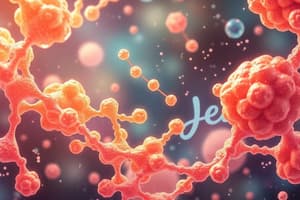Podcast
Questions and Answers
Which item is NOT associated with disaccharides?
Which item is NOT associated with disaccharides?
- O-glycosidic linkages
- Never having free anomeric carbons (correct)
- Formation of a ketal or acetal
- Sucrose
Homopolysaccharides contain a single monomeric sugar species.
Homopolysaccharides contain a single monomeric sugar species.
True (A)
What O-glycosidic bond is commonly found in amylose, amylopectin, and glycogen?
What O-glycosidic bond is commonly found in amylose, amylopectin, and glycogen?
- (α16)
- (β14)
- (β16)
- (α14) (correct)
A glycogen molecule with 28 branches has how many nonreducing and reducing ends?
A glycogen molecule with 28 branches has how many nonreducing and reducing ends?
Why is it logical for sugars to be added to only one end of glycogen?
Why is it logical for sugars to be added to only one end of glycogen?
Even though amylose and cellulose are made of similar homopolysaccharide chains, they have very different properties. Why?
Even though amylose and cellulose are made of similar homopolysaccharide chains, they have very different properties. Why?
What structural features do cellulose and glycogen share, and in what ways do they differ?
What structural features do cellulose and glycogen share, and in what ways do they differ?
What structural features do D‑glucose and D‑fructose share, and in what ways do they differ?
What structural features do D‑glucose and D‑fructose share, and in what ways do they differ?
What structural features do maltose and sucrose share, and in what ways do they differ?
What structural features do maltose and sucrose share, and in what ways do they differ?
Select the statements that accurately describe the differences between a hemiacetal and a glycoside.
Select the statements that accurately describe the differences between a hemiacetal and a glycoside.
What chemical property of fructose could account for the decreased sweetness at high temperatures?
What chemical property of fructose could account for the decreased sweetness at high temperatures?
Why does sucrose not have any anomeric forms?
Why does sucrose not have any anomeric forms?
Select all of the sugars that are classified as reducing sugars.
Select all of the sugars that are classified as reducing sugars.
Classify each characteristic as describing glycoproteins or proteoglycans.
Classify each characteristic as describing glycoproteins or proteoglycans.
What amino acid residues of antithrombin III are likely to interact with heparin?
What amino acid residues of antithrombin III are likely to interact with heparin?
What is glucosyl?
What is glucosyl?
What is a lectin?
What is a lectin?
A(n) ________ is a(n) ________ with two monosaccharide units.
A(n) ________ is a(n) ________ with two monosaccharide units.
What chemical feature determines if a sugar is an aldose or a ketose?
What chemical feature determines if a sugar is an aldose or a ketose?
Glucose is a monosaccharide with a(n):
Glucose is a monosaccharide with a(n):
Why does (R,S)-aspartame NOT stimulate the sweet receptor?
Why does (R,S)-aspartame NOT stimulate the sweet receptor?
Which statement is false regarding the enantiomers of glyceraldehyde?
Which statement is false regarding the enantiomers of glyceraldehyde?
A monosaccharide with a ketone functional group and seven carbons:
A monosaccharide with a ketone functional group and seven carbons:
What name is given to monosaccharides that differ in configuration about the hemiacetal carbon atom?
What name is given to monosaccharides that differ in configuration about the hemiacetal carbon atom?
Cyclization of monosaccharides:
Cyclization of monosaccharides:
Using the Fischer projection of D-glucose, identify which statement is true of the Haworth perspective formula of α-D-glucopyranose.
Using the Fischer projection of D-glucose, identify which statement is true of the Haworth perspective formula of α-D-glucopyranose.
Which reaction is one that is NOT common of glucose?
Which reaction is one that is NOT common of glucose?
What term is given to carbohydrates linked by their anomeric carbons?
What term is given to carbohydrates linked by their anomeric carbons?
Even though amylose and cellulose are made of similar homopolysaccharide chains, they have very different properties. Why?
Even though amylose and cellulose are made of similar homopolysaccharide chains, they have very different properties. Why?
Why are chitin and cellulose hydrophobic and essentially insoluble in an aqueous media?
Why are chitin and cellulose hydrophobic and essentially insoluble in an aqueous media?
Polysaccharides:
Polysaccharides:
Which characteristic is NOT one that is true of glycosaminoglycans?
Which characteristic is NOT one that is true of glycosaminoglycans?
The glycosaminoglycan hyaluronan:
The glycosaminoglycan hyaluronan:
Which statement about glycoconjugates is false?
Which statement about glycoconjugates is false?
Which statement about proteoglycans is false?
Which statement about proteoglycans is false?
A laboratory is studying the binding properties of a glycoprotein on the plasma membrane. What amino acids should they analyze for the presence of branched heteropolysaccharides?
A laboratory is studying the binding properties of a glycoprotein on the plasma membrane. What amino acids should they analyze for the presence of branched heteropolysaccharides?
Glycoproteins:
Glycoproteins:
Which of these is NOT a glycoconjugate?
Which of these is NOT a glycoconjugate?
Oligosaccharides are:
Oligosaccharides are:
Glycosaminoglycans?
Glycosaminoglycans?
Types of glycosaminoglycans?
Types of glycosaminoglycans?
Hyaluronan?
Hyaluronan?
Uronic acid?
Uronic acid?
Distinctions between hyaluronan and heparan, chondroitin, etc. sulfates?
Distinctions between hyaluronan and heparan, chondroitin, etc. sulfates?
How does heparan sulfate bind to proteins?
How does heparan sulfate bind to proteins?
Heparan?
Heparan?
Glycoconjugate?
Glycoconjugate?
Proteoglycans?
Proteoglycans?
Glycoprotein?
Glycoprotein?
Glycosphingolipids?
Glycosphingolipids?
How do glycosaminoglycans connect to proteins?
How do glycosaminoglycans connect to proteins?
Two families of membrane heparan sulfate proteoglycans?
Two families of membrane heparan sulfate proteoglycans?
GPI anchor?
GPI anchor?
Antithrombin binds to and inhibits the protease thrombin only in the presence of heparan sulfate.
Antithrombin binds to and inhibits the protease thrombin only in the presence of heparan sulfate.
How does heparan sulfate bind antithrombin?
How does heparan sulfate bind antithrombin?
Proteoglycan aggregates?
Proteoglycan aggregates?
Two types of attachments for oligosaccharides in glycoproteins?
Two types of attachments for oligosaccharides in glycoproteins?
Examples of glycoproteins?
Examples of glycoproteins?
Which statement about selectins is false?
Which statement about selectins is false?
Lectins:
Lectins:
The ________ does NOT need to be determined in fully characterizing oligosaccharides and polysaccharides.
The ________ does NOT need to be determined in fully characterizing oligosaccharides and polysaccharides.
Which of these sugars is nonreducing?
Which of these sugars is nonreducing?
Flashcards are hidden until you start studying
Study Notes
Carbohydrates Overview
- Oligosaccharides consist of short chains of monosaccharides linked via glycosidic bonds; the most common are disaccharides (two monosaccharide units).
- Monosaccharides can be classified as aldoses or ketoses based on the position of the carbonyl carbon; aldoses have the carbonyl at the end, ketoses have it at any other position.
Monosaccharide Characteristics
- Glucose is an aldohexose, containing an aldehyde group and six carbon atoms.
- A monosaccharide with a ketone functional group and seven carbons is called a ketoheptose.
- Anomers are monosaccharides differing only at the hemiacetal carbon configuration.
- Cyclization of monosaccharides leads to ring structures through the formation of hemiacetals or hemiketals.
Glycosidic Bonds and Nonreducing Sugars
- When the anomeric carbon forms a glycosidic bond, the sugar becomes a nonreducing sugar due to the lack of free anomeric carbons.
- Proteins decorated with carbohydrates (glycoproteins) can be enriched in certain amino acids like Ser, Thr, and Asn for oligosaccharide attachment.
Polysaccharides
- Polysaccharides, also known as glycans, can be homopolysaccharides (same monosaccharide units) or heteropolysaccharides (different monosaccharide units).
- Cellulose features β-glycosidic linkages that create strong fibers through hydrogen bonding, while amylose forms helices through α-glycosidic linkages.
Glycosaminoglycans
- Glycosaminoglycans (GAGs) are linear polymers of repeating disaccharide units often found in the extracellular matrix.
- Hyaluronan, a type of GAG, consists of alternating D-glucuronic acid and N-acetylglucosamine residues and is important for tissue hydration.
Glycoproteins and Glycoconjugates
- Glycoproteins can have one or several oligosaccharides covalently linked, influencing their structure and function in biological processes.
- Glycoconjugates comprise carbohydrates linked to proteins or lipids, playing critical roles in cell recognition and signaling.
Special Terms and Functions
- Heparan sulfate is a GAG involved in various cellular processes, including binding to antithrombin to inhibit clot formation.
- Selectins mediate immunological functions and cell recognition, being found on the plasma membrane but are not intracellular.
Sugar Reducing Properties
- Nonreducing sugars do not have free anomeric carbons; trehalose, a disaccharide, is an example.
- Glycosidic linkages (like α1→4 in amylose and glycogen) determine the structure and properties of polysaccharides.
Summary of Key Functionalities
- Proteoglycans are macromolecules made of proteins and sulfated GAGs, important in extracellular interactions and stability.
- Antithrombin binding to heparan sulfate highlights the interplay between carbohydrates and protein functions in physiological processes.
- Distinction between homopolysaccharides and heteropolysaccharides is crucial in understanding their roles as structural or storage forms in biological systems.### Glycogen Structure and Function
- Glycogen has 28 branches, resulting in 29 nonreducing ends and 1 reducing end.
- Sugars are added primarily to nonreducing ends, facilitating rapid glucose storage and release.
- Glycogen's architecture allows simultaneous enzyme action on multiple branches, enhancing glucose availability.
Amylose vs. Cellulose
- Amylose and cellulose are both polysaccharides of D-glucose but differ in linkage types: cellulose with β(1→4), amylose with α(1→4).
- Cellulose forms stable, hydrophilic fibers due to hydrogen bonding, while amylose creates helical structures that exclude water.
Cellulose and Glycogen Comparisons
- Both consist of D-glucose; however, cellulose has β(1→4) linkages and is linear, while glycogen has α(1→4) linkages and is branched.
D-Glucose vs. D-Fructose
- Both sugars are hexoses; glucose is classified as an aldohexose, while fructose is a ketohexose.
Maltose vs. Sucrose
- Both are disaccharides; maltose consists of two α(1→4)-linked D-glucose units, while sucrose features α(1→2β)-linked D-glucose and D-fructose.
Hemiacetals and Glycosides
- Glycosides are formed when hemiacetals condense with alcohol.
- Hemiacetals arise from the condensation of an aldose with alcohol.
- Disaccharides contain glycosidic bonds, important for sugar classification.
Fructose and Temperature Effects
- Fructose can cyclize, favoring the furanose form at higher temperatures, leading to reduced sweetness in honey and corn syrup when heated.
Anomeric Forms of Sugars
- Sucrose has no free anomeric carbon, preventing mutarotation, while lactose exhibits two anomeric forms.
Reducing Sugars
- Reducing sugars include N-acetyl-glucosamine, D-lactose, and α-D-glucose due to their ability to donate electrons.
Glycoproteins vs. Proteoglycans
- Glycoproteins are located in Golgi complexes, secretory granules, and lysosomes, and contain high-affinity binding sites.
- Proteoglycans consist solely of sulfated glycosaminoglycan chains linked to serine and are found at the cell surface and in the extracellular matrix.
Heparin's Role as an Anticoagulant
- Heparin binds to antithrombin III, increasing its ability to inhibit coagulation by inducing conformational changes through interactions with positively charged residues.
Additional Terms
- Glucosyl: a univalent radical derived from the hemiacetal form of glucose.
- Lectin: a protein with high-affinity carbohydrate binding, facilitating cell-cell interactions, often involving oligosaccharides.
Studying That Suits You
Use AI to generate personalized quizzes and flashcards to suit your learning preferences.




